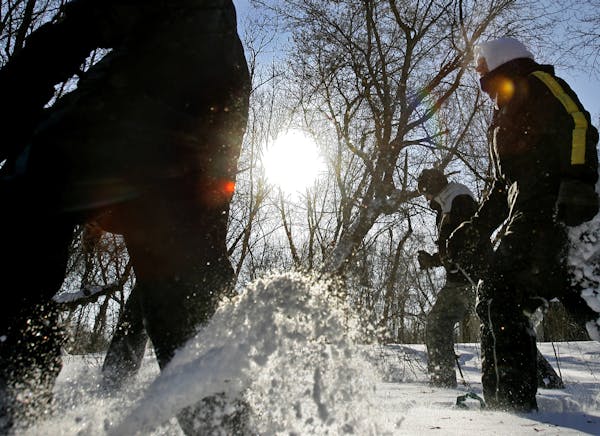Across the nation, fewer people are enjoying the great outdoors. But Minnesota is swimming against that current, with more people using the state's parks and trails.
Visits were up nearly 20 percent overall last year — more people bought daily and year-round permits, and more stayed overnight to camp.
Those numbers were points of pride at a 125th anniversary celebration for Minnesota Department of Natural Resources (DNR) state parks and trails Friday, held against an idyllic snowfall at Fort Snelling State Park.
"Minnesota is so blessed to have a remarkable system of parks and trails and places where everybody in Minnesota can go out and enjoy our incredibly beautiful state," Lt. Gov. Tina Smith said at the event.
The state system, which predates the national system, includes 75 state parks and more than 600 miles of paved trails. Over the past 60 years, the annual number of visitors has increased from about 1 million to more than 8 million. And in 2015, nearly half a million people bought daily and annual permits.
DNR officials point to the Clean Water, Land and Legacy Amendment — which provides funding for parks and trails through a statewide sales tax — as the reason behind the recent rise in visitor numbers. Since the amendment passed in 2008, sales of daily and annual parks permits have risen by nearly 150,000.
Legacy money has been used to improve marketing, facilities and programming, which in turn have brought more people into the parks, said parks and trails
director Erika Rivers. New visitors can learn the how-tos of outdoor activities such as camping or kayaking, using equipment provided by the DNR. In warmer weather, students in Minneapolis and St. Paul can hop aboard big voyageur canoes — a program offered through a partnership with an outdoor exploration nonprofit.
Meanwhile, a recent stretch of good weather, much of it landing on weekend days, hasn't hurt, Rivers said.
It's an unusual picture: Research shows that nature-based recreation has been declining in the U.S. since the 1990s. A 2007 study by researchers at the University of Illinois and Bryn Mawr College found that, after a half-century of rising visitorship at national parks, the numbers started declining in 1987. Specific activities such as camping and fishing also became less popular during that time.
Though numbers at Minnesota's state parks are rising, the state as a whole isn't immune from those changes. In its 2014-2018 comprehensive outdoor recreation plan, the DNR warned of the decline in nature-based recreation, pointing to factors including decreased interest from young people, an aging population and limited funding.
"We have seen, over an extended period of time, an increase in the use of and visitorship in Minnesota state parks," Rivers said. "But in general, there has been an overall decline in various forms of outdoor recreation."
There's some disagreement among researchers about the severity of the decline, said Amit Pradhananga, a University of Minnesota researcher who's working with a team to create a statewide parks usage survey. For one thing, park users' interests are changing — even though fishing may be declining, for example, paddleboarding is on the rise.
Still, DNR officials know they have more work ahead of them, including efforts targeting young families and minority populations. Among the people who visit parks and trails in Minnesota, the vast majority are white. Many, too, are retired baby boomers with time and resources to spend outdoors.
So what's at stake? The future of these natural areas, potentially.
"As the recreation numbers decline, what we see is a sign of detachment from nature," Pradhananga said. "If they're not attached, then we might see negative impacts on environmental protection in general."
Emma Nelson • 952-746-3287

In Grand Rapids, Itasca Pride is planning its first event, but there is already pushback
One person shot at YMCA in Coon Rapids

BCA says man pointed pistol-style BB gun at officers before he was shot in Woodbury

Former diversity worker sues University of Minnesota after firing over swastika photo

